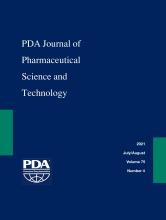Some users have been hesitant to take on the validation of alternative methods. However, recombinant factor C (rFC) tests are so highly analogous to the horseshoe crab-sourced Limulus amebocyte lysate (LAL) tests that users should consider their advantages. They include sustainability, safeguarding the supply chain because of geographic diversity, accuracy, specificity, and reproducibility. Also noteworthy is that rFC is gaining acceptance in most of the world, with its own compendial chapter (2.6.32) in the European Pharmacopoeia (1) and a new section written in the Chinese Pharmacopoeia. Although given the delay of the USP, let us consider the “ease of validation” according to USP <1225> (2) as detailed in the Q&A format following.
What Needs to Be Done for rFC Method Validation?
With an operationally qualified reader installed, generally a full validation can be achieved in as little as 2 days, with six rFC assays, including two operators and three reagent lots to determine all necessary validation parameters.
What is Bacterial Endotoxin Testing (BET) Validation?
USP <85> (3) requires verification of bacterial endotoxin tests (BETs) using LAL, but not validation. Verification is a check of the product’s suitability in the test matrix, whereas validation requires the demonstrations of multiple parameters (accuracy and so forth, see following). As they are considered alternative methods to LAL tests in the USP, rFC assays require initial validation of the method using purified water. That is the performance qualification 1 (PQ1), a one-time per site test. Subsequently, the verification/suitability testing (PQ2) is the same as USP <85>, a test for interference factors (inhibition/enhancement; Figure 1).
Qualification process for bacterial endotoxin testing, both Limulus amebocyte lysate and recombinant factor C assays.
Why Favor an rFC Assay?
rFC is produced from a natural genetic sequence from horseshoe crabs in a tightly controlled biotechnological process. Thus, it is more standardized and reproducible across lots than the animal-extracted LAL (4, 5). Rising demand can be met sustainably by upscaling rFC manufacturing without constraints such as the population of or access to horseshoe crabs. Moreover, some rFC reagents are stable at room-temperature once combined and allow all-day use from a single preparation.
What About the Authorities?
The U.S. Food and Drug Administration (FDA) and the European Directorate for the Quality of Medicines & Healthcare (EDQM) have both recognized these advantages and equivalency. They both published guidance that specifically mentioned rFC assays for BET (6, 7). The FDA’s 2012 Q&A guidance document refers to USP Chapter <1225> Validation of Compendial Procedures (2) (equivalent to ICH Q2(R1) (8)) to demonstrate the desired validation parameters. Accordingly, rFC validation demonstrates eight acceptable aspects: accuracy, precision, specificity, linearity, range, detection limit, quantitation limit, and robustness.
Do We Need to Demonstrate All Eight Aspects?
No. Primary validation of rFC assays (4, 9) and the scientific literature (10) have already been used successfully with FDA-approved products. This type of validation compared rFC assays to kinetic-turbidimetric and -chromogenic LAL tests from different manufacturers and clearly demonstrated that rFC assays were equivalent or superior to the LAL tests for all of the mentioned quality attributes. Accordingly, rFC users may omit robustness testing and considerably tailor their efforts on the other aspects.
What Does Specificity Mean for BET?
According to USP (2), specificity refers to the ability to detect endotoxin in the presence of other substances (“exclusivity”). However, specificity may also be interpreted as the capability of detecting different varieties of endotoxin (“inclusivity”). The Pharmaceutical and Medical Device Agency of Japan (PMDA) had up to five laboratories compare three rFC and LAL assays, respectively, on 18 purified lipopolysaccharides, 5 crudely purified endotoxin samples from cultivated bacteria, and 6 water samples with endogenous endotoxin (“naturally occurring endotoxin”, NOE) (11, 12). A fundamental difference between rFC and LAL testing could not be shown and therefore demonstrated equivalent specificity. A meta-analysis on rFC vs. LAL comparisons confirmed these results (13).
Is a Side-by-Side Comparison with LAL Required for Validating an rFC Assay?
You do not need to use both methods in parallel. If a LAL test has not been established, there is no transition to begin with. On the other hand, previous LAL users can simply refer to the PMDA studies (11, 12), a comparative review (13), and a primary validation (4) for this purpose, that is, focus on rFC exclusively. Respective data from LAL testing needs to be compared, if it is available, only to demonstrate rFC method suitability on three lots of product, that is investigation of inhibition/enhancement (compendial test for interfering factors).
With the aforementioned comparative studies and some preparatory testing, rFC can be quickly validated and working as intended in a given laboratory.
rFC manufacturers may support rFC users by supplying primary validation reports as well as ready-to-fill-out protocols and worksheets. Thus, method validation and suitability testing become a straightforward process (Figure 1). Adding hardware and software installation and operational qualification (IQ, OQ), preparatory testing, and operator training—the same as required for LAL—rFC establishment can take just 5 days in the laboratory.
What Comes Next?
rFC will become compendial in Europe on January 1, 2021 (1) and the method validation requirement will thus become obsolete. As the respective Ph. Eur. chapter 2.6.32 became effective on July 1, 2020, rFC implementation can start already without method validation. Given the pharmacopoeia harmonization pushed by the ICH, USP and JP/China will follow in time. Then again, should six assays keep you from adopting a more standardized, sustainable, specific, and stable reagent right now? Do not let the fear of validation stop you from receiving the benefits of rFC.
Conflict of Interest Declaration
Thomas Uhlig, Kevin L. Williams, and Brendan Tindall are employees of bioMérieux, a manufacturer of rFC assays. There is not any other financial interest.
- © PDA, Inc. 2021







